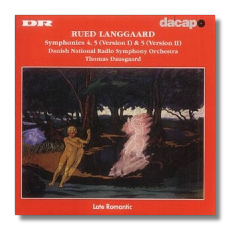
The Internet's Premier Classical Music Source
Related Links
- Latest Reviews
- More Reviews
-
By Composer
-
Collections
DVD & Blu-ray
Books
Concert Reviews
Articles/Interviews
Software
Audio
Search Amazon
Recommended Links
Site News
 CD Review
CD Review
Rued Langgaard

Symphonies
- Symphony #4 "Løvfald"
- Symphony #5 "Steppenatur" (Versions I and II)
Danish National Radio Symphony Orchestra/Thomas Dausgaard
Da Capo 8.224215 DDD 57:17
Rued Langgaard, Denmark's rugged individualist from the first half of the Twentieth Century, wrote sixteen symphonies. All of them have been recorded by a Polish orchestra conducted by Ilya Stupel on the Danacord label. Now another cycle is in progress, brought to us by Dausgaard and the DNRSO. This is the third release. Earlier discs have been devoted to Symphonies 6-8 (Da Capo 8.224180) and 9-11 (Da Capo 8.224182).
The Fourth and Fifth Symphonies were written during World War One, while Langgaard still was in his twenties, and before he became completely embittered to the Danish musical establishment that refused to understand or even to perform his works. Both symphonies betray the composer's interest in nature and its cyclical patterns. In English, the subtitle of the Fourth Symphony is "Leaf-fall." In the words of annotator Bendt Viinholt Nielsen, it is an "autumn diary" of sorts, beginning with what the composer identifies as a "despairing forest murmur" and continuing through "Tired" and "Over!," with stops in between. Less a symphony than a 23-minute symphonic poem, "Løvfald" eschews traditional thematic development in favor of a large and varied canvas of moods, impressions, and colors. What structure there is comes from the reappearance of certain themes and passages from time to time. The music conveys fatalism without depression – the inevitable squeezing of life from the summer forest, and the tense stillness that seems to precede the first snowfall. The late Romantic idiom is not difficult on the ears, and it is possible to hear the influence of Carl Nielsen and Jean Sibelius in this symphony. Pathos and strength commingle throughout.
Langgaard continued to tinker with this symphony until as late as 1950, but it exists in a single version today. The summery Fifth Symphony is a different story, however, as there are two distinct versions. It is the second version that has been recorded in the past; this is the première recording of the first version, which has been published as a separate work. It is about five minutes shorter, and it contains a good deal of thematic material that is unique to it. Langgaard, apparently was inspired by the legend of nixes, male sirens of the woodland, if you will, who lure travelers to a watery death with their violin-playing. The subtitles "Elf Land" and "Steppe Landscape" also provide keys to the interpretation of this work. The first version is more episodically constructed, in the manner of the Fourth Symphony. The second version is based – loosely! – on sonata form. Again, this is rather free-form late Romantic music, and its idiom is typically Scandinavian.
Dausgaard and the DNRSO are polished, if a little reticent, in these works, and no one should be disappointed with these performances. (Stupel and his Polish orchestra really throw themselves into Langgaard, but the results are rawer.) Danish Radio's engineering gets the job done without spectacle.
Copyright © 2002, Raymond Tuttle


















